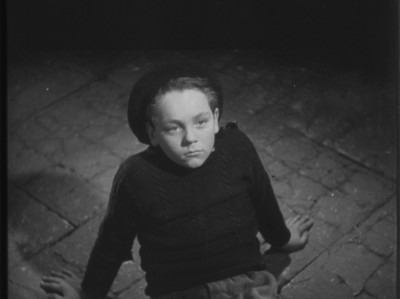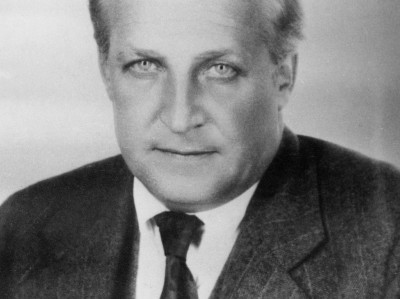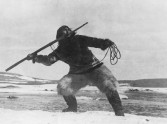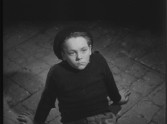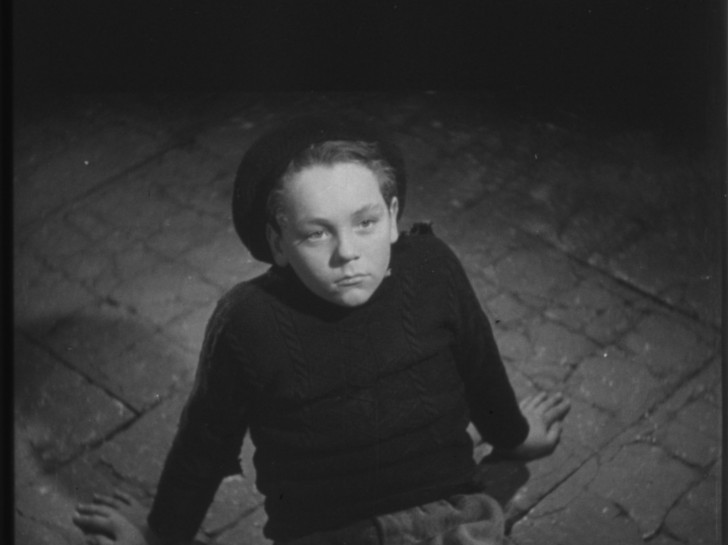
A Night of Storytelling
Man of Aran
A lost film until the 2013 discovery of a 35mm nitrate print at Harvard University, Robert Flaherty’s 1935 short film Oidhche Sheanchais offers a disarming and fascinating distillation of his ardent belief in cinema as a mythopoeic art and folkloric tradition. To record the soundtrack of Man of Aran Flaherty brought the principal members of his cast to London, inviting Colman “Tiger” King, Maggie Dirrane, Patch “Red Beard” Ruadh and young Michaeleen to retrospectively add dialogue, in English and in pre-Jean Rouch fashion, to select scenes of the film. During their extended stay in London Flaherty reassembled the nuclear family invented for Man of Aran for a second film commissioned by the Department of Education, gathering his four “actors” around a sound studio hearth, together with famed seanchai (story-teller) Seáinín Tom Ó Dioráin. In striking contrast to Man of Aran, the resultant film, Oidhche Sheanchais, was recorded entirely in the dialect of the Aran Islands and is, in fact, considered the first talkie in the Irish language. Speaking and singing in their native tongue, Dirrane, Ruadh and especially O’Diorain deliver beautifully animated performances that bring a rare intimacy to Oidhche Sheanchais, making clear Flaherty’s unique relationship to his actors and giving new human dimension to these now legendary men, woman and child of Aran.
The surging, symphonic poetry of Man of Aran is powerfully emblematized in Flaherty’s bold imagery of the restless North Atlantic whose unyielding waves and currents unceasingly threaten the fishermen’s boats and very lives. All of Flaherty’s feature films are anchored in just such a mythologization of Man locked in an eternal struggle with Nature. Oidhche Sheanchais stands apart, then, as a purely interior film, set entirely within a sound stage and without any of the lyrical nature imagery so central to Flaherty’s visionary cinema. Yet, despite its explicit interiority and literal enclosure within an artificial studio set, Oidhche Sheanchais remains, like Flaherty’s other films, an adventurous exploration of a vast, unchartered land. For Oidhche Sheanchais is, above all, a film about the interior yet fathomless world of the imagination, a limitless realm from which emerges the song and story shared by the fireside group, each a fantasy echo of central themes of Man of Aran. In this way Ó Dioráin’s fiery telling of a well-known tale of Irish water spirits who tempt yet are ultimately tamed by an Aran fisherman, makes explicit the animistic and deeply Romantic vision of nature animating both Flaherty’s cinema and the folkloric world that so inspired him. And Maggie Dirrane’s moving rendition of the Irish ballad, recalls the longing, melancholy and even dark tragedy which defines lives dependent upon the sea.
As both a figure of a world out of time and a kind of a portal to the imagination, Oidhche Sheanchais’ minimal set also beautifully recalls the cottage hearth tended by Maggie Dirrane in Man of Aran; a miniaturized and seemingly self-sustaining world, a domestic island, with chickens and lambs warming themselves alongside the baby’s cradle while a kettle heats above the fire. An embodiment of the “infinite immensity” described by Gaston Bachelard, the hearth fire is also where young Michaeleen, in one Man of Aran’s loveliest moments, drifts to sleep, followed by a montage of images of the restless ocean that seem to spring from the boy’s dreams of joining his father’s oceanic adventure. As backdrop to O’Diorian’s spirited story-telling, the dancing shadow and flame of the hearth fire in Oidhche Sheanchais is also, of course, a figure for cinema itself, bringing a meta-cinematic dimension to Flaherty’s reanimation of ancient tradition. As Flaherty’s first work with direct sound, the film crackles with the miracle of the new technology and its ability to so vividly render the cadence and lilt of the Aran dialect spoken and sung by the actors. And yet the figure of Tiger King, the Man of Aran himself, seems still locked in another realm, standing fixed in a statuesque pose, not speaking a word, a figure then for the lost and receding world of the silent cinema.
By his third film, Flaherty’s formula was well established: unsparing, process-oriented portraits of resourceful men and their clans eking out a living off the grid. This time the location of choice was the rocky seashore of Ireland, and funding was sourced from the native country. The result, Man of Aran, is a film reverent of its resilient protagonist even as it acknowledges his sure fate to one day “meet his master—the sea.” Befitting this resigned tone, Flaherty alternates furiously between the macro and the micro, intercutting God’s eye perspectives and shots from the level of his vulnerable subjects. Brisk montage editing—notably in a suspenseful sequence dramatizing a two-day attempt to capture a basking shark—is juxtaposed against more contemplative landscape imagery that emphasizes the overwhelming force of the ocean environment, always reducing its inhabitants’ dubbed voices to unintelligible wails of resistance. The gendered titles of Flaherty’s early films often bely the fact that these group portraits are equally about the women in each respective male character’s life, and in this case the protagonist’s tough wife emerges as one of the more memorable faces from Flaherty’s young career.
